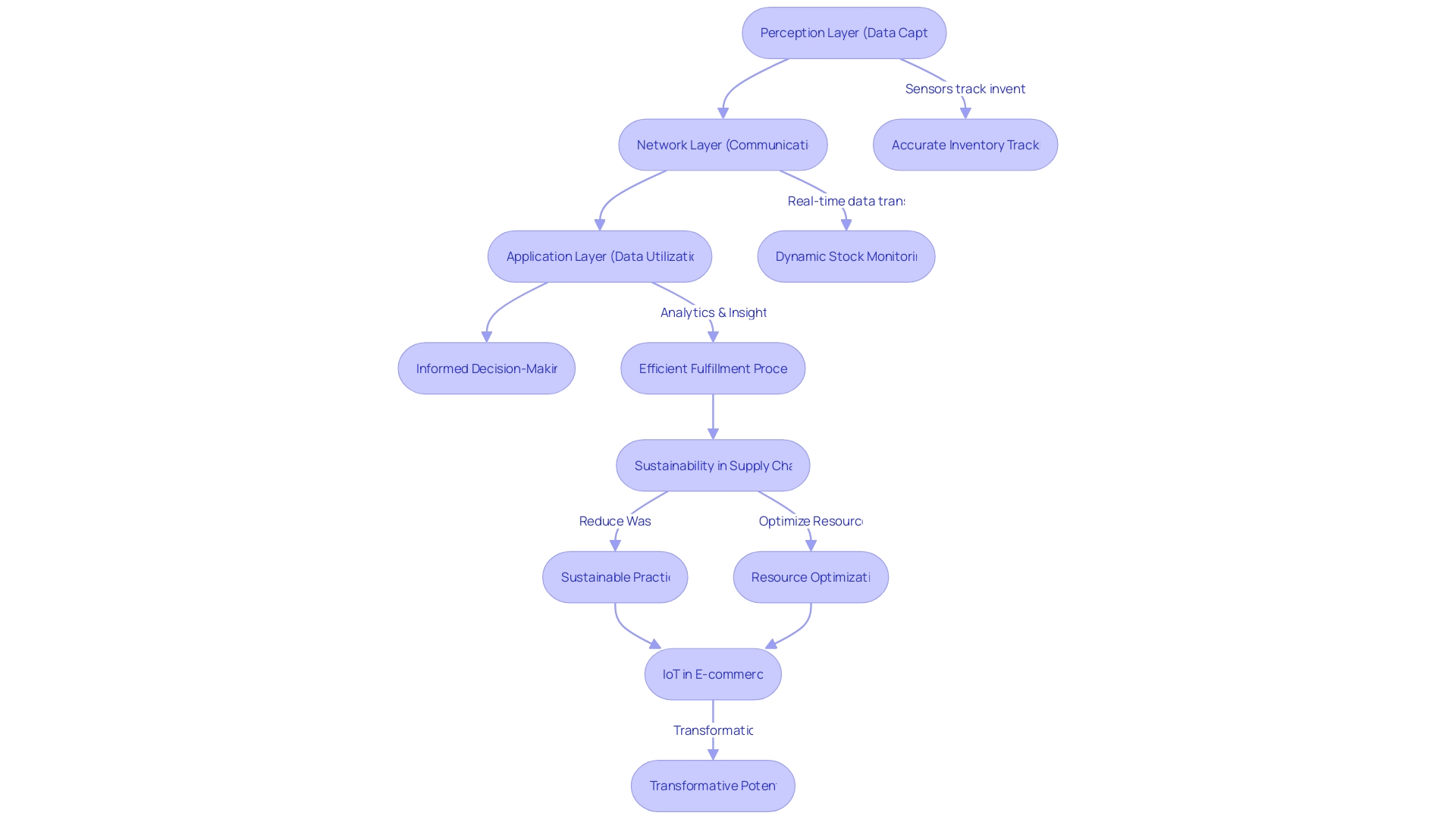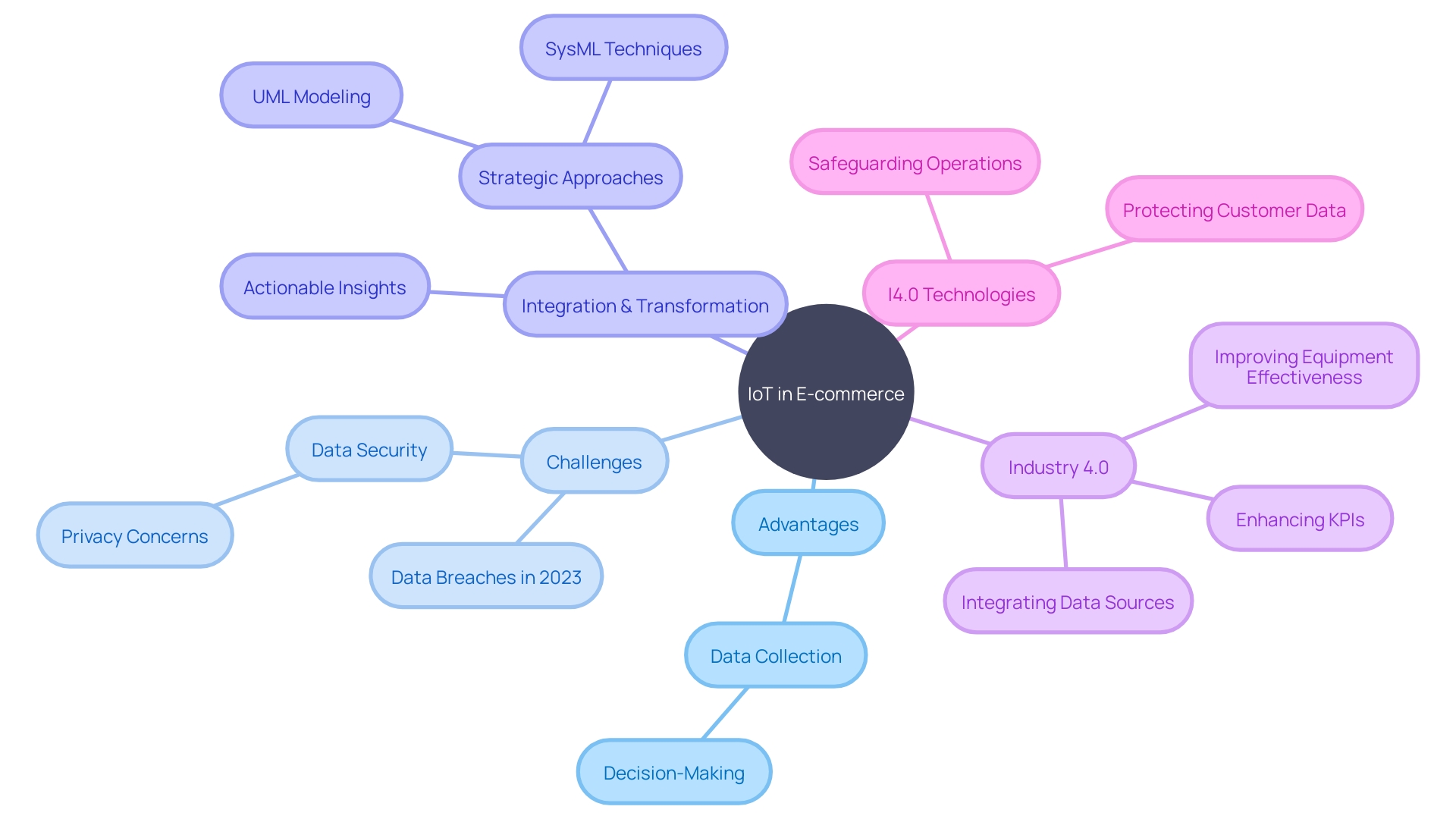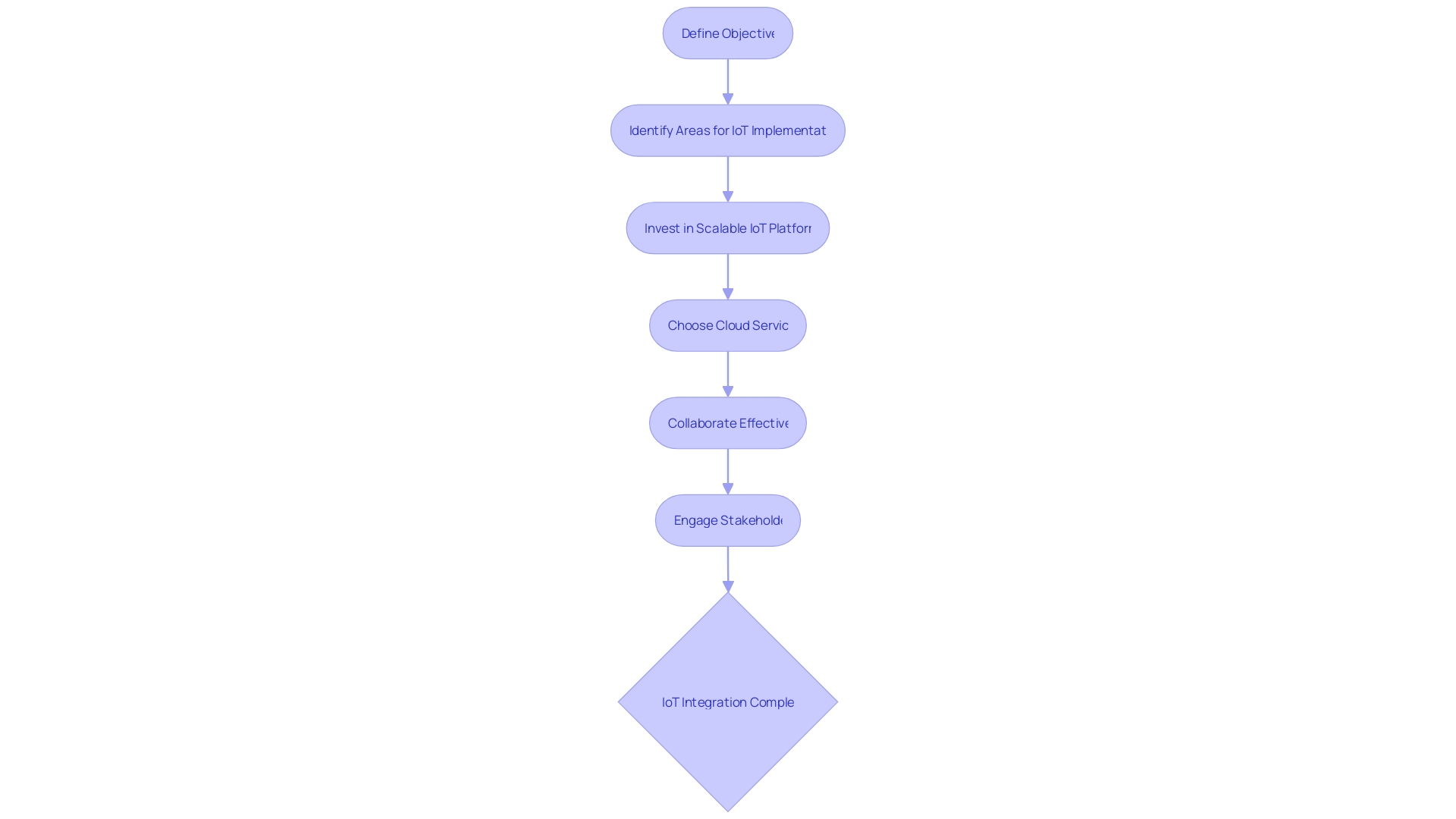Introduction
The integration of Internet of Things (IoT) technology in e-commerce is transforming the industry, revolutionizing operations and opening up new possibilities. With interconnected devices and sensors, real-time data collection and exchange become seamless, enabling automation and efficient communication.
This article explores key components of IoT for e-commerce success, including the use of IoT devices and sensors, IoT platforms and cloud services, applications in inventory management and logistics, customer service and experience, as well as the challenges and best practices for implementing IoT in e-commerce. By delving into these topics, businesses can gain insights on how to leverage IoT to optimize their operations, enhance customer engagement, and stay ahead in the competitive e-commerce landscape.
Key Components of IoT for E-commerce Success
E-commerce enterprises are leveraging the Internet of Things (IoT) to revolutionize their operations. It's interconnected network of devices and sensors is pivotal for real-time data collection and exchange, fostering automation and seamless communication.
This technology is not just transformative for retail but is also essential in addressing global challenges. With the anticipated global population surge to 9.8 billion by 2050, efficiency in industries like agriculture is crucial.
IoT, alongside AI and machine learning, is equipping professionals with data-driven insights to complement their experience, thus optimizing production even in the face of climate adversities affecting sectors such as cattle farming. In retail, digital signage represents a practical IoT application, enhancing customer engagement and operational efficiency.
These smart objects don't just convey messages to consumers; they also gather valuable data that can refine business operations. The Business Research Company highlights a projected growth in the digital signage market by nearly 8% annually from 2022 to 2024. Reasons for this growth include improved customer experiences and more efficient communication channels. By integrating digital signs with IoT, retailers can interact with customers innovatively while harnessing collected data to boost their profitability.
IoT Devices and Sensors in E-commerce
The integration of IoT technology into e-commerce is a transformative leap towards Industry 4.0, where the interconnectedness of smart devices and sensors revolutionizes how we manage inventory and streamline operations. These technologies not only capture and transmit valuable data but also play a crucial role in enhancing operational efficiency and cutting costs.
Smart shelves, for instance, automatically monitor stock levels, while RFID tags offer real-time tracking of goods, providing a wealth of data that can be harnessed to optimize supply chain processes. Beacons and wearable devices further contribute to this ecosystem by improving in-store experiences and assisting in workforce management.
As the global population approaches 9.8 billion by 2050, the adoption of such advanced IoT applications in e-commerce becomes not just a matter of economic benefit but a pressing necessity for sustainable growth. In the face of climate challenges impacting sectors like agriculture, IoT's data-driven insights are indispensable. They empower businesses to make informed decisions, transitioning from traditional intuition-based practices to ones bolstered by the certainty of data analytics, machine learning, and artificial intelligence. This shift is aligned with the vision of Industry 4.0, as defined by IoT Analytics, which emphasizes the integration of modern tech stacks to enhance Overall Equipment Effectiveness (OEE) and optimize key performance indicators crucial to manufacturing and production-related industries.
IoT Platforms and Cloud Services for E-commerce
Harnessing the power of IoT in e-commerce transcends mere connectivity; it entails the sophisticated management of a deluge of data originating from a myriad of devices. This data, arriving in both structured and unstructured formats, poses a formidable challenge in storage and processing.
To navigate this complexity, businesses must adopt robust platforms and cloud services capable of not only housing this vast information but also transforming it into actionable insights. Without advanced integration and transformation processes, companies risk succumbing to information overload, which can impede the actionable analysis of IoT data.
In the context of Industry 4.0, as defined by IoT Analytics, businesses are encouraged to utilize modern tech stacks or supporting technologies that facilitate the integration of diverse data sources. This approach can significantly enhance Overall Equipment Effectiveness (OEE), drive down costs, and improve other key production KPIs.
It's crucial to recognize that manufacturers may have differing perspectives on Industry 4.0 and IIoT, with some focusing on technology architecture with substantial on-premises components, and others prioritizing operational efficiency and cost reduction. When considering the implementation of IoT in e-commerce operations, it is essential to assess the environment, which encompasses the types of devices used, the software stack they're equipped with, the operational objectives, and the expected connectivity. The scale of the device fleet, their locations, functions, and the degree of operational control required are also key considerations. Especially when dealing with remote devices in uncontrolled environments, businesses must ensure built-in control over the device lifecycle and maintain remote visibility into their current status. This strategic approach to IoT enables e-commerce businesses to effectively manage and analyze data, leading to more informed decisions and streamlined operations.
IoT Applications in E-commerce: Inventory Management and Logistics
The advent of the Internet of Things (IoT) has revolutionized the e-commerce landscape, particularly in the realm of inventory management and logistics. As we delve into the architecture of IoT, it becomes clear that its multi-layered structure, including the Perception, Network, and Application layers, is pivotal in optimizing supply chain processes. The Perception layer, with its ubiquitous sensors such as RFID, serves as the eyes and ears of the system, capturing critical data in real time.
This data is then transmitted via the Network layer, ensuring seamless communication across various nodes, and finally processed and utilized in the Application layer to drive informed decision-making. In the context of inventory management, these IoT technologies empower businesses to not only track inventory with unprecedented accuracy but also to monitor stock levels dynamically, ensuring that the fulfillment process is both swift and precise. This capability is crucial in today's fast-paced market where efficiency equates to competitive advantage.
Moreover, recent trends in the industry underscore the significance of sustainable retail innovation. The integration of IoT in supply chain management is not just about efficiency; it's also about embracing sustainability. With the cost of implementing such technologies becoming more accessible, and with increased pressure from climate pledges and sustainability targets, businesses are now able to scale their IoT solutions in a way that aligns with their core values of sustainability.
Furthermore, the emergence of AI Innovation in retail is testament to the value It brings beyond the proof-of-concept stage. Retailers are now harnessing It to scale up their operations, leveraging data-driven insights to enhance overall equipment effectiveness (OEE) and improve key performance indicators (KPIs), thus bridging the gap between traditional practices and the cutting-edge Industry 4.0 paradigm. This operational shift is not solely focused on technological upgrades but also on achieving operational goals with an emphasis on efficiency and cost savings, illustrating the transformative potential of IoT in e-commerce.

IoT Applications in E-commerce: Customer Service and Experience
Another area where IoT can greatly benefit e-commerce businesses is in customer service and experience. IoT devices and sensors can be used to gather data on customer preferences, behavior, and satisfaction levels. This data can then be used to personalize marketing campaigns, offer targeted recommendations, and provide proactive customer support.
Challenges and Considerations for IoT in E-commerce
As the Internet of Things (IoT) becomes increasingly integrated into e-commerce operations, it's clear that this technology brings potent advantages, such as the ability to collect a wealth of data to drive decision-making. However, the deluge of data generated by IoT devices presents significant challenges, particularly in terms of ensuring data security and maintaining user privacy. The sheer volume of structured and unstructured data can quickly become overwhelming, requiring advanced integration and transformation processes to yield actionable insights.
Notably, Retail Technology Review has highlighted the prevalence of data breaches in 2023, affecting a wide range of organizations and underscoring the critical need for robust cybersecurity measures. To address these challenges, e-commerce businesses must adopt strategic approaches, such as modeling techniques like the Unified Modeling Language (UML) and Systems Modeling Language (SysML), which have already proven successful in enhancing software quality and reusability within manufacturing system software engineering. These methods, as suggested by experts like Mili et al., offer a path to improved usability and a more seamless development methodology that could be pivotal for application and process control engineers in the future.
Moreover, the concept of Industry 4.0, as defined by IoT Analytics, provides a framework for manufacturers to integrate various data sources, improve overall equipment effectiveness (OEE), and enhance key performance indicators (KPIs). This involves navigating the technological architecture of Industry 4.0, which can range from on-premises solutions with hardware retrofits to a focus on operational efficiency and cost savings. Embracing these modern I4.0 technologies is essential for e-commerce businesses aiming to safeguard their operations and customer data against the ever-evolving threat landscape.

Best Practices for Implementing IoT in E-commerce
In the rapidly evolving landscape of e-commerce, integrating IoT technologies is not a mere luxury but a strategic imperative. To harness the full potential of IoT, businesses must establish clear objectives that align with their overarching strategy.
This involves identifying the specific areas where IoT can enhance operational efficiency and customer satisfaction. Investing in scalable IoT platforms is vital to manage the data influx efficiently.
Moreover, the choice of cloud services should reflect the business's need for robust, secure, and adaptable data storage solutions. Effective collaboration across various departments ensures that IoT solutions are woven seamlessly into the fabric of the company's existing infrastructure.
This level of integration requires asking the right questions about the environment, the number and function of devices, and the necessary operational control. As the global population surges towards 9.8 billion by 2050, the imperative for efficiency becomes even more critical. IoT, along with AI, machine learning, and genetic modifications, will be pivotal in addressing these challenges. By engaging stakeholders early and providing data-driven evidence of It's value, businesses can cultivate internal champions for technology adoption, ensuring a competitive edge in the e-commerce domain.

Conclusion
In conclusion, IoT technology is revolutionizing e-commerce by enabling real-time data collection, automation, and efficient communication. By leveraging IoT devices and sensors, businesses can enhance operational efficiency, cut costs, and address global challenges like sustainable agriculture.
IoT devices and sensors play a crucial role in inventory management, logistics, and customer service in e-commerce. They enable businesses to track goods in real-time, personalize marketing campaigns, and offer proactive customer support.
The adoption of advanced IoT applications becomes essential for sustainable growth as the global population expands. To harness the power of IoT effectively, businesses must utilize robust platforms and cloud services capable of managing and transforming vast amounts of data into actionable insights.
Integration of diverse data sources enhances overall equipment effectiveness (OEE) and improves key production indicators. IoT has significant applications in inventory management and logistics, optimizing supply chain processes for swift fulfillment.
It also enables sustainable retail innovation by aligning with sustainability goals. Challenges arise with data security and user privacy concerns in IoT implementation. However, strategic approaches like modeling techniques and embracing Industry 4.0 concepts can address these challenges effectively. Implementing IoT in e-commerce requires clear objectives aligned with business strategy, investment in scalable platforms and secure cloud services, effective collaboration across departments, and early stakeholder engagement. In summary, leveraging IoT technology is crucial for optimizing operations and enhancing customer engagement in e-commerce. By understanding the key components of IoT success and implementing best practices while addressing challenges effectively, businesses can unlock the full potential of this transformative technology.





